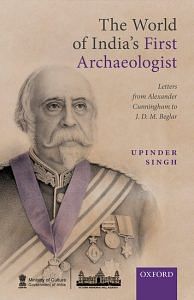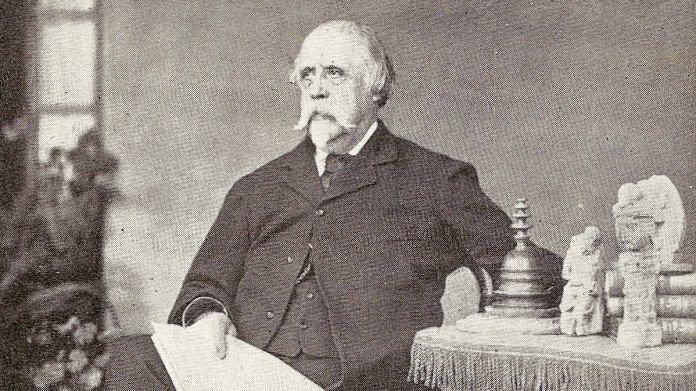This book opens a third, remarkable window, revealing unknown facets of the life and career of Alexander Cunningham and the history of Indian archaeology during its crucial formative stage. In 2005, Victoria Memorial Hall, a premier museum and cultural institution in Kolkata, acquired a set of handwritten letters, mostly written by Cunningham to his Archaeological Assistant Beglar between 1871 and 1886. These letters do not represent the entire correspondence between Cunningham and Beglar.
Beglar seems to have received other letters as well, and we do not have Beglar’s letters to Cunningham. But what we do have is exciting enough. The 192 letters published for the first time in this book, arranged in chronological order, reveal the progression of Cunningham’s ideas and experiences and tell the story of the history of Indian archaeology in the 1870s and 1880s in the voice of the chief protagonist.
Cunningham usually spent winters in the field and most of the letters were written while he was on the march or camped at sites. In summer, he hastened to the cool of the hills to write his reports; several letters were written from Fir Hill in Simla. Some were written from Calcutta, the political centre of the British Government of India, from places such as the Great Eastern Hotel (now The LaLiT Great Eastern Kolkata) and 15/2 Chowringhee (the site is now occupied by the Oberoi Grand Hotel). Others were penned in Roorkee, where Cunningham’s son Allan taught in the Thomason College of Civil Engineering (now the Indian Institute of Technology, Roorkee).
The last few letters were written after he returned to his home in Cranley Mansion on Gloucester Road in South Kensington, London.
The first letter is dated 28 January 1871, soon after Cunningham took over as Director General of the newly established Archaeological Survey of India. It was a formal invitation to Beglar—who was at the time working with the Public Works Department of the Bengal Government—to join his team. Cunningham pointed out that the job of Archaeological Assistant would be much more interesting than the duties of a PWD engineer.
I feel satisfied that to any one who has a taste for Ancient Buildings the work will be a pleasant one. (Letter no. 1)
The salary offer was Rs 100 per month, in addition to allowances, and a travelling allowance of Rs 5 when in the field. A man ‘who showed zeal and an aptitude for the work’ could look forward to a swift pay increase and prospects of permanent employment. Cunningham had heard of Beglar’s interest in photography and asked him to send across some of his photographs. The letter had an urgency to it. He wanted Beglar to decide immediately whether he wanted the job and to let him know when he could begin work.
There is a long gap between that first letter and the next one, which must have been written in March/April 1874 (Letter no. 2). By then, the formal relationship between the two men had turned into friendship. ‘Dear Sir’ had made way for ‘My dear Beglar’ and the content and tone indicate a close personal and professional bond. The frequency of communication varied. Sometimes Cunningham wrote to Beglar every day, sometimes several times in a day. There were also lean periods.
On 7 June 1883, he wrote:
It seems to me quite an age since I have heard from you, or have written to you—and I am now anxious to hear about your welfare. Where are you, How are you, and what are you doing? (Letter no. 166)
Also Read: The Class of Taxila — how Mortimer Wheeler set up the first Indian archaeology school
Three letters in our corpus were written after Cunningham returned to England. The last one is dated 12 October 1888. Cunningham could not have known that over a century and a half later, his letters to Beglar would be published. The frank expression of ideas by the head of the Archaeological Survey to a close friend and associate throws valuable light on Cunningham’s personality as well as on the history of the archaeological enterprise.
The letters offer a first-hand contemporaneous account of the exciting discoveries that laid the foundation of early Indian archaeology. While Cunningham’s publications present the results of the archaeological explorations and investigations; the letters describe the labours that produced those results, as well as the triumphs, errors, and dead ends.
The Cunningham of the Archaeological Reports and archival files is an exceptionally diligent, disciplined, hard-working man, utterly devoted to his work. He is serious, impersonal, and unflappable, given to dry documentation rather than enthusiasm or flights of fancy, except for occasionally bursting into verse. The Cunningham of the letters too is serious and utterly devoted to his work. But he is also passionate, excitable (the letters contain a great deal underlining and many exclamation marks, all of which have been retained in the transcriptions in this book), affectionate, humorous, and extremely invested in his personal relationships.
At one stroke, these letters humanize Cunningham and the story of nineteenth-century Indian archaeology. They reveal the mind, method, and personality of India’s first archaeologist and describe his life and world in his own words.
Also Read: Why Delhi’s grand monuments will always remember young archaeologist Gordon Sanderson
In the 1870s and 1880s, the Archaeological Survey of India was basically a three-man team consisting of Cunningham and his two Assistants, along with a handful of support staff. This single fact makes their achievements all the more remarkable. Cunningham and Beglar worked out and coordinated their itineraries so that they could meet while conducting their fieldwork. Beglar sent Cunningham his draft reports for comments. Cunningham responded, sometimes with generous praise.
Apart from the two Assistants, the staff sanctioned by the government included one draughtsman, two measurers, two servants, and six temporary hands. Your strong point is your account of Temples and of their connexion with one another —And this is just one of the very best points that you could possess for our work. This faculty of seizing upon all resemblances as well as differences in design, construction, and ornamentation is invaluable. (Letter no. 44)
He could also be ruthlessly critical. He criticized Beglar for being diffuse, told him to improve his spelling, grammar, and diacritics, and to stop indulging in excessive speculation.
I have already pointed out to you that you deal too much in speculation—and that you seem to me to adopt theories in opposition to the opinions of mature scholars like Sir William Jones, Colebrooke, etc. Your theory about the Erannoboas (or Hiranyabahu) being the Gandak is a case in point—and your idea that Patna was not Pâṭaliputra is another. (Letter no. 44)
However, criticism was accompanied by personal warmth and humour. In 1878, Cunningham joked that he hoped that Beglar had not run off to assist the Czar with the money he had sent him (Letter no. 93). In the same year, he told Beglar that he had sent a copy of Ashoka’s inscriptions to the Russian scholar, J. P. Minayeff, adding jokingly, When the Russians take India I shall look to him and to you for protection. (Letter no. 100)
Also Read: Archeologist who found 4,500-yr-old skeletons in Haryana doesn’t buy Aryan invasion theory
The letters often close affectionately with good wishes to Beglar’s father and his younger son Bull (‘Salam to my old friend Bull’). The letters of the 1880s end with: ‘Believe me always, Your sincere friend.’
Cunningham’s relationship with Carlleyle, his other Assistant, was completely different. He referred to him rarely and usually tersely, mentioning where he was, what he was doing and, more often, what he was not doing. Carlleyle had produced a report on Rajputana but Cunningham wanted to tour Rajputana himself, along with Beglar (Letter no. 62). Carlleyle’s reports were two years behind schedule and he had not furnished even one photographic plate (Letter nos 113, 115, and 146). Cunningham complained of his frequent ‘insane fits of silence’ (Letter no. 12).
It is charitable to believe him mad. (Letter no. 12)
In 1880, Beglar left the Archaeological Survey to take up the conservation of the Mahabodhi temple and was replaced as Archaeological Assistant by H. W. B. Garrick. Cunningham was dissatisfied with Garrick’s work:
You are quite right about Mr. Garrick. He is a very slippery fellow—like his father before him. (Letter no. 146)
He complained that Garrick was useless and lazy; that he knew nothing about Indian history or antiquities; that he could not spell; and that one of his accounts was marked by ‘infantile ignorance’ (Letter nos 143 and 161). However, on one occasion, he grudgingly acknowledged that Garrick had performed better than expected (Letter no. 148). One of Garrick’s advantages was that he took photographs, which became an increasingly important part of archaeological documentation (Letter nos 145 and 148).
While the officers of the Archaeological Department were Europeans (or in Beglar’s case, of Eurasian descent), the lower staff were Indians. The duties performed by the latter often stretched beyond what might be expected from their designation.
 This excerpt from ‘The World of India’s First Archaeologist: Letters from Alexander Cunningham to JDM Beglar’ edited by Upinder Singh has been published with permission from Oxford University Press.
This excerpt from ‘The World of India’s First Archaeologist: Letters from Alexander Cunningham to JDM Beglar’ edited by Upinder Singh has been published with permission from Oxford University Press.



